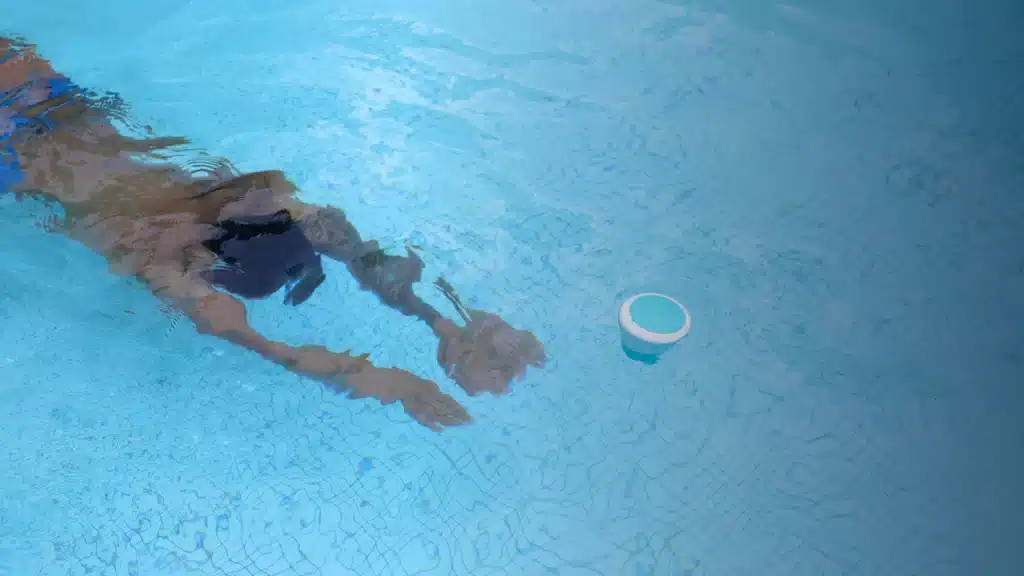If you have a pool treated with chlorine, you need to know the difference between stabilized and non-stabilized chlorine. Chlorine treatment is the most widely used disinfection method for treating pool and spa water, due to its low cost. It's a powerful treatment against algae growth and bacteria. In this article you'll find all the information on the advantages and disadvantages between these two products so you can choose the one that's right for you.

Chlorine is the most commonly used water disinfection treatment in swimming pools, due to its effectiveness and low cost. Although chlorine is extremely effective, it does have one drawback: the sun's UV rays have a major impact on its effectiveness. When the UV index is high (mainly in summer), chlorine rapidly degrades until it disappears. The quality of your pool water also deteriorates rapidly. To solve this problem, you can manually add stabilizer or use stabilized chlorine, which is an all-in-one product. This is why we speak of two types of chlorine: stabilized and non-stabilized.
As a general rule, the chlorine level in water should ideally be between 1.5 and 2 mg/l p to disinfect and prevent the development of algae and bacteria. To measure it, there are :

The main difference between the two lies in the presence or absence of a stabilizer in the chlorine.
Unstabilized chlorine, such as calcium hypochlorite, does not contain this stabilizer, giving it specific active and reactive properties. It comes from the HTH chlorine family, which includes all hypochlorites, i.e. chlorine derivatives containing no stabilizer (e.g. bleach).
Stabilized chlorine or chloroisocyanurate is a chlorine derivative containing cyanuric acid (the chlorine stabilizer). The latter limits the impact of UV rays on chlorine.
Stabilizer protects chlorine and reduces the impact of UV rays on its rapid decomposition. As a result, chlorine remains active for longer. While the idea of prolonging chlorine's disinfectant action is exciting, as always with chemical products, you need to control the dosage. Stabilizer should be within a range of 30-50 ppm (30-50 mg/liter). When the stabilizer level is too high, it blocks the disinfectant action of chlorine. The result is the opposite of the desired effect.
You'll find unstabilized chlorine on the market, to which a stabilizer is added to complete the treatment. Chlorine with stabilizer is also available (cyanuric acid is indicated in the product's composition). You'll find it under the names Chlore multi-fonction or galets tout en un (with stabilizer, algicide and clarifier).
We recommend using stabilized chlorine for small pools. Examples include above-ground pools, mini-pools and spas. Finally, if you live in a particularly sunny region and your pool is subject to high UV levels, there's no doubt that stabilized chlorine is ideal for maintaining healthy water.
Stabilizer is not destroyed and concentrates in the water little by little. This can lead to over-stabilization of the water, totally unbalancing it to the point where it can no longer catch up. If your water is over-stabilized, you'll need to drain your pool (by about 1/3) to bring this level down. Only then will the chlorine action be effective again. So always be vigilant.
As you can see, this product should be used with care to maintain healthy water. To avoid over-stabilizing your water and control the dosage, you can :
Unstabilized chlorine, as the name suggests, generates no stabilizer in the pool water. It is particularly effective when the pH of the water is naturally mild (low pH). This depends on the water quality in your region.
Secondly, this product has the added advantage of being less odorous, which is generally more pleasant for bathers. Finally, if you have an indoor pool or one with low UV exposure, there's no need to add stabilizer. You can therefore use this product to maintain good water quality.
As we explained earlier, unstabilized chlorine is not UV-resistant and deteriorates very quickly. It also has two other notable disadvantages:
Unstabilized slow chlorine provides continuous disinfection over an extended period. It comes in the form of solid pebbles or sticks. They dissolve slowly in the water, gradually releasing the active chlorine.
Unstabilized shock chlorine is a more concentrated form. It is particularly effective for treating heavy contamination such as algae or blurred water. It's generally available in granulated or powder form. This enables rapid dissolution and a more powerful disinfectant action.
Stabilizer remains present in water for a very long time without dissolving. As a result, stabilizer can build up in the water. This increases the risk of the water in your pool or spa spinning. Stabilizer levels should be between 30 and 50 mg/litre (30-50 ppm). An overdose renders chlorine ineffective, and the proliferation of bacteria, algae and fungi is inevitable. If this happens, use only non-stabilized chlorine to avoid aggravating the situation. In case of serious imbalance, you may need to consider draining part of the water from your pool.
It's possible and even recommended to alternate between stabilized and non-stabilized chlorine, depending on the weather. In summer, when UV levels are high, stabilized chlorine will enable you to maintain the effectiveness of chlorine disinfection. Conversely, in mid-season or when the weather is milder, unstabilized chlorine will be effective.
Stabilized chlorine is slower-acting than unstabilized chlorine. During busy periods, usually in summer, it's essential to check the chlorine level in your pool every week, and the stabilizer level after each treatment.
Caution: the mixture of stabilized and non-stabilized chlorine in water is extremely hazardous to health and equipment. This can lead to extremely violent reactions, including explosions. If you alternate between the two, it's essential to clean your pool and equipment thoroughly. Activate filtration for 24 hours, then thoroughly clean your pool's filters and walls.
Your product label will indicate its composition and the presence of cyanuric acid. It is also possible to perform a water test with specific strips to measure the presence of stabilizer.
As indicated in this article, chlorine levels should be between 1.5 and 2 mg/l of water. You should therefore use more or less stabilizer in high season (high UV) to stabilize it. Finally, you should be aware that adding chlorine will tend to raise the pH of the water. The higher the pH, the less effective your chlorine disinfectant. It's a bit like the snake biting its own tail: make sure that chlorine and pH are within the recommended thresholds to keep your water balanced.
The electrolyzer converts salt into chlorine. In general, salt water treatment requires much less stabilizer than a chlorine-treated pool. However, if your pool is located in a very sunny area with high UV indexes, you should be aware that stabilized salt containing isocyanuric acid is available. The maximum dosage is 25 mg/litre (25 ppm), otherwise the stabilizer will block the disinfectant action of the chlorine.
| Cookie | Duration | Description |
|---|---|---|
| cookielawinfo-checkbox-analytics | 11 months | This cookie is set by GDPR Cookie Consent plugin. The cookie is used to store the user consent for the cookies in the category "Analytics". |
| cookielawinfo-checkbox-functional | 11 months | The cookie is set by GDPR cookie consent to record the user consent for the cookies in the category "Functional". |
| cookielawinfo-checkbox-necessary | 11 months | This cookie is set by GDPR Cookie Consent plugin. The cookies is used to store the user consent for the cookies in the category "Necessary". |
| cookielawinfo-checkbox-others | 11 months | This cookie is set by GDPR Cookie Consent plugin. The cookie is used to store the user consent for the cookies in the category "Other. |
| cookielawinfo-checkbox-performance | 11 months | This cookie is set by GDPR Cookie Consent plugin. The cookie is used to store the user consent for the cookies in the category "Performance". |
| viewed_cookie_policy | 11 months | The cookie is set by the GDPR Cookie Consent plugin and is used to store whether or not user has consented to the use of cookies. It does not store any personal data. |